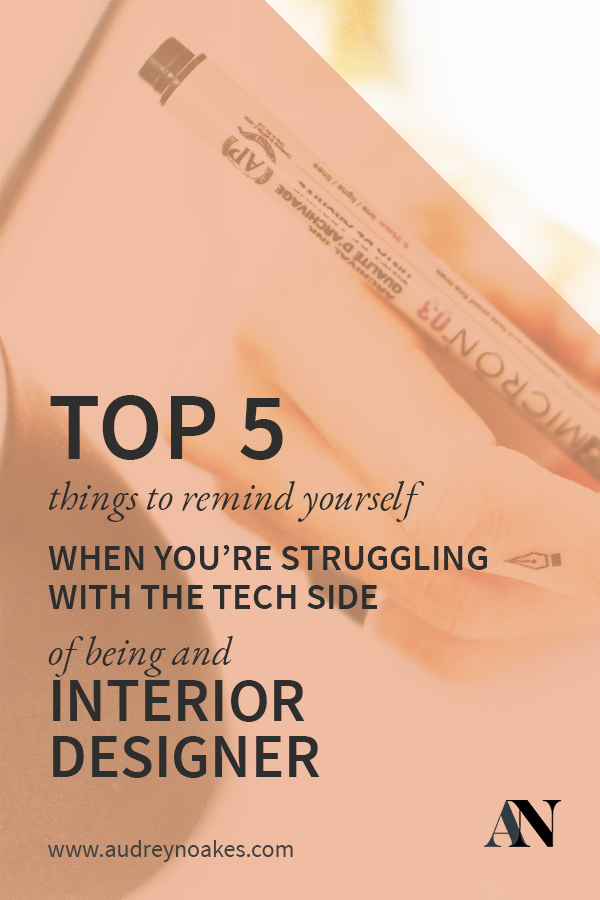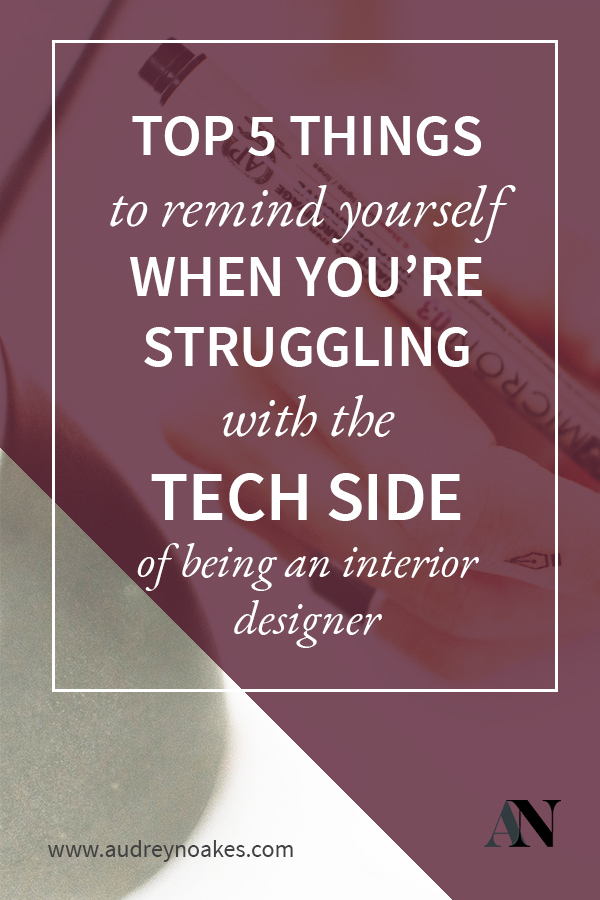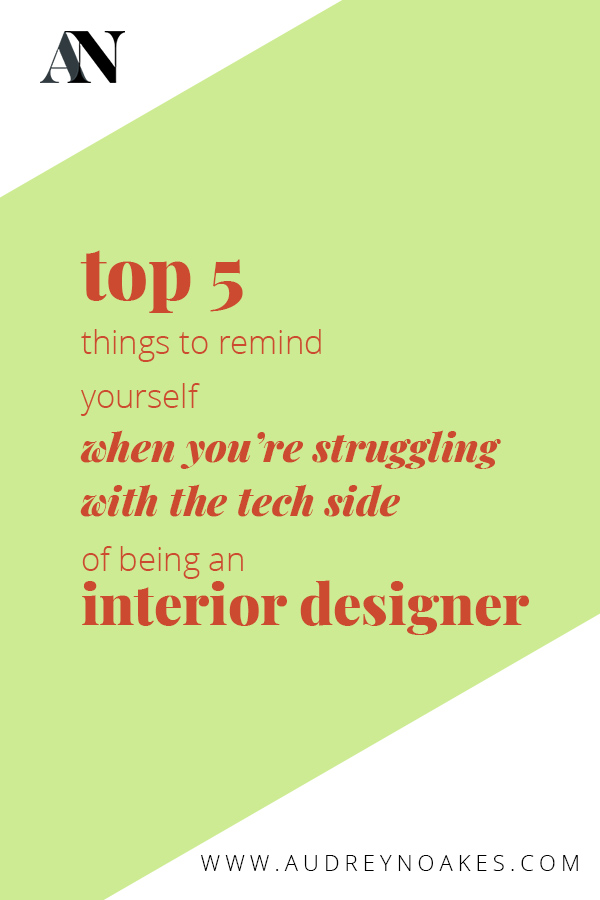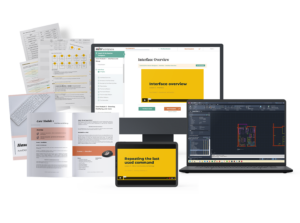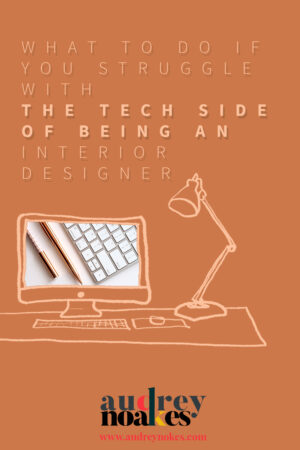I know that feeling of being overwhelmed and not knowing how to work all the software and tech gizmos that are involved in being an interior designer. Today’s industry is so very different than it was even 20 years ago. You’re expected to create your designs via complex and sometimes inaccessible software. It seems like every job posting requires about 5 software programs. Inevitably, there’s one that you’ve never even heard of. If you’re working on your own, it can sometimes feel like you’re drowning in managing it all, but you haven’t quite crossed that line of being able to hire an assistant. If any of these sound familiar, I’m very glad you arrived at this post.
I’m here to tell you that you can overcome all that overwhelm and frustration. The software and tech side of being an interior designer can in fact be the part of your job that feels easy. It can be the part of your job that makes things run smoothly. Yes, learning all the digital skills of being an interior designer won’t always help you with needy clients and cranky contractors. But it will help you manage your end. It will help you organise and streamline that chaos it seems you’re currently working in.
But before you start learning (or re-learning) these skills, to improve you design process and manage your projects and practice, there are 5 things I want you to keep in mind. Print them out and hang ‘em up if you have to.
- You’re fully capable of learning these skills.
- Don’t get caught in the comparison trap.
- These skills are going to make you more efficient.
- These skills are going to make you more competitive in this industry.
- All the frustration will be worth it.
Let’s look at each of these closer.
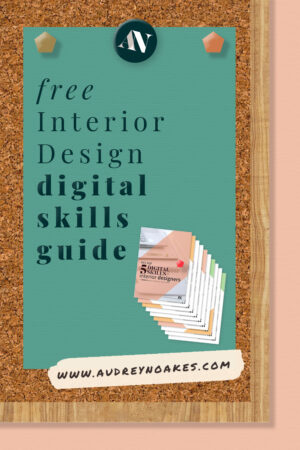
want your free digital skills for interior designers guide?
1. You’re fully capable of learning these skills.
As a teacher, this is probably the concern I hear most: I’m not tech-y enough to learn these skills. I also hear, I’m too old to learn these skills. If there was ever a load of B.S., it’s this. I’ve seen hundreds of students, of all ages, with time and practice learn these skills.
These skills didn’t come easy to me either, I promise. When I was in school, I liked the sketching, drawing, and modelling aspects of design. If someone asked me to produce a hyper-realistic digital rendering, I would have stared back blankly, torn between laughing and crying. In fact, if you asked anyone I went to university with if I was the tech-savvy one in the class, they would point to likely well over a dozen other people who were more talented, more capable, and more knowledgeable than me when it comes to the tech-side of being a designer. But you know what? I eventually learned.
That first year in the industry, I had to. I worked in a busy practice that held its employees to high standards. Therefore, I had to buckle in and force myself to learn these programs completely. Learn to use them well, and learn to use them smart. Now, as a teacher, I feel like I can tackle almost any software or tech problem a student throws at me. And there are a lot…
The point is you can learn these skills, too. Now, the point of this site is not for you to learn them the hard way, with long hours, tears, and waste, but learn them the smart way. The smart way means these skills will make your life easier, make you more efficient, and make you more competitive with your fellow designers.
2. Don’t get caught in the comparison trap.
Speaking of your fellow designers, don’t get caught in the comparison trap. If there was ever an enemy to success, it was comparing your beginning to someone else’s middle.
“Don’t compare your beginning to someone else’s middle.” – Tim Hiller, Strive: Life is Short, Pursue What Matters
I see this far too often with my students. Wanting to run before you can walk will lead to frustration and burn-out. Don’t compare yourself to others. When you look to designers who have been in the industry 5, 10, even 20 years, and you wonder why can’t I do things like that, you’re just setting yourself up for disappointment. See the reality in this comparison. You’re comparing someone with likely 1,000s of hours of experience to yourself who is just starting out.
Now if you’ve been in the business a while, and I are just starting to learn the digital skills involved with this industry, I want you to avoid the comparison trap, too. If you see younger designers, effortlessly working through software programs bringing ideas to life, keep in mind that it took them a lot of practice to get there. How can they have had a lot of practice, Audrey, they’re 22?! (I hear this a lot, too). They had practice even in their childhood. Childhood was different in the last 10/15 years. Video games and computer programs gave children (whether they know it or not) a foundation to understanding the world of 3D modelling, digital drafting, and all these digital skills. Therefore, when it came time for them to learn these skills to apply professionally, the groundwork was already there.
No matter where you are in your career, if you’re just starting out in learning the digital skills of being an interior designer, I want you to stop yourself from comparing yourself to others. Shut that little voice up in your head that sees a beautiful website or a beautiful rendering and says why am I not doing that… That voice doesn’t help anything. You will be capable of working through these digital skills. I promise. And I’m going to try and make it easier for you.
3. These skills are going to make you more efficient.
Now, in the beginning, this statement will feel false. You’re still learning, and there will always be a bit of slowing down to ensure you’re doing it right. But imagine your working life, in a year’s time. Imaging your life in five years’ time. Suddenly, when you need to create a 3D model to really explain to your client how all the elements of your design are coming together, will it take you a solid 4-weeks of late nights? No, you’ll be in the position of Give me a day, and I’ll put something together to help you visualise the scheme. You’ll be in the position of fitting this task within all the other tasks of your working life. You’ll be in the position where it might actually be fun.
Not all digital skills will relate to modelling and drawing though either. Imagine you have a website that runs on autopilot accepting enquiries and setting up meetings. Imagine you have templates, drafts, and scheduling set up where your inbox becomes a streamlined machine, rather than an enormous time-sink. If time is money, there is immense value in learning these skills.
4. These skills are going to make you more competitive in this industry.
More and more designers are arming themselves with these digital skills to make them more competitive in the industry. More interior designers are becoming savvy with creating high-standard architectural drawings. More interior designers are producing digital renderings. More interior designers are becoming savvy social media queens and kings. Yes, a lot of design companies have started outsourcing many of these aspects of their practice. But not everyone can afford to outsource every aspect of their business. Also, what happens when the outsourced products aren’t quite what you had in mind? Or what happens when the meeting is tomorrow, and only you have time to work on it today?
Even if you eventually plan to have staff or subcontractors help you with many aspects of the tech-side of your practice, it is entirely in your benefit to have a working knowledge of these skills. S*%& happens. Things like unavailable subcontractors or unavoidable downsizing happen. This industry is at the mercy of so many factors that you can’t always plan for them. Therefore, having your own working knowledge of these skills is important. That way, even if the worse happens, you can carry on with your work and keep it at the same level your clients are used to.
5. All the frustration will be worth it.
Knowing that all the frustration will be worth it is pretty much looped in with all of the other things, too. I’ve made it a separate point though for you to remember by itself though. When your computer crashes, or when your mouse sticks, or when it’s 11:30 and you just want to lie down, you need to remember that the frustration will be worth it.
First of all, lie down. Too many designers, think sleep is negotiable. Don’t let it be.
Second of all, there’s never been a push-button solution to putting all the skills you want to learn automatically in your brain. Maybe they’ll come up with something one day, but right now, you will still have to put in the time, effort, and inevitable frustration to achieve the results you want. That’s ok. It will be worth it in the end. Your confidence, your efficiency, your competitiveness, and your success will always be worth it.
That being said, I do hope I can help make it easier for you. 🙂
If you want to know more about the digital skills that I think are most valuable for an interior designer to learn, download my free guide. In it, I discuss the specific software and skills I think are best for this industry. I also throw in a few extra tips too.
Until next time,
Audrey
